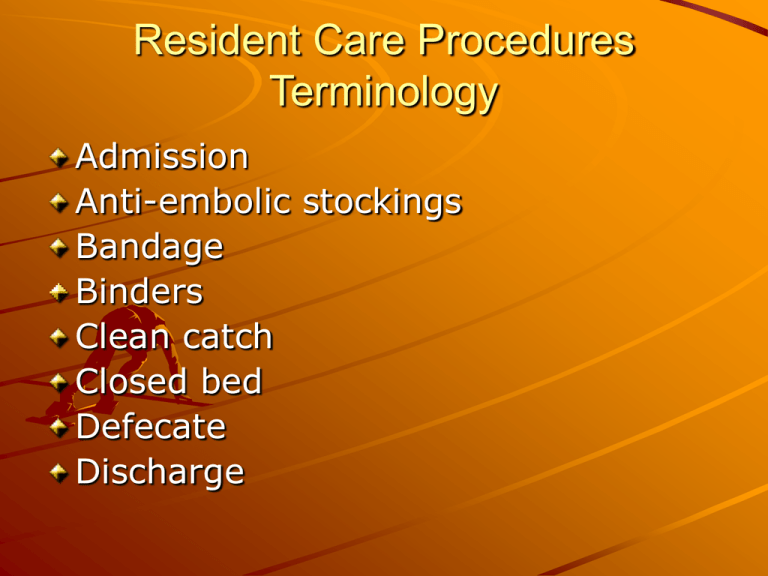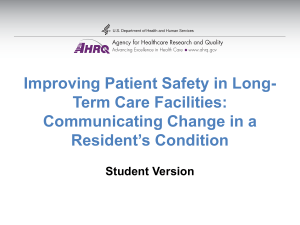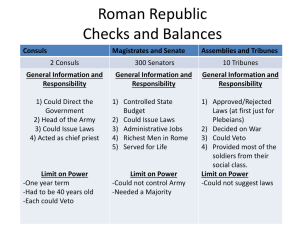Document
advertisement

Resident Care Procedures Terminology Admission Anti-embolic stockings Bandage Binders Clean catch Closed bed Defecate Discharge Terminology #2 Drawsheet Edematous Elastic bandage Electric bed Evacuation Excoriated Expectorate Fan fold Terminology #3 Fluid Gastrostomy Gatch Hives Intake Integumentary system Intravenous Lesions Terminology #4 Manual bed Mitered corner Mucus Nasogastric Non-prescription Occupied bed Ointment Open Bed Terminology #5 Output Pruritus Reverse Trendlenberg Scaling Semi-Fowler’s position Side rails Specimen Terminology #6 Suppository T.E.D. hose Transfer Trendlenberg Unoccupied bed Collecting sputum specimens Reason for study sputum Blood Microorganisms Abnormal cells Collecting sputum specimens – Role of NA Usually coughed up in early AM Allow resident to rinse mouth with water Do not use mouthwash May be embarrassing to the resident Specimen may be perceived as unpleasant Collecting urine specimens – Methods of collection Mid-stream Clean catheter urine specimen 24-hour urine specimen Fresh-fractional urine (second void) Collecting urine specimens – Role of NA Wash hands before and after Use Standard Precautions Use correct and clean container Label the container accurately Collecting urine specimens – Role of NA #2 Do not touch inside the container Ask resident not to have a BM while specimen is being collected Take specimen and requisition slip to the designated lab pick-up station Document that specimen was obtained Collecting stool specimens – Purpose Blood Fat Micro-organisms Worms Any abnormal contents Collecting stool specimens – Role of NA Maintain privacy Use Standard Precautions Give clear instruction Label container accurately Clarify if specimen must be kept warm or at room temperature Take specimen and requisition slip to the designated lab pick-up station Bed making - Role of NA Linen must be wrinkle-free Keep call bell clipped to linen Keep resident reality-oriented by use of resident’s personal pillow, afghan, etc. Bed making - Role of NA #2 Wash hands before and after Hold and carry linen away from uniform Do not shake linens Keep linens off the floor or bedside table Soiled linen hampers kept covered Hospital Bed – Functions and structures Manually operated beds Electric beds Side rails Bed Positions High positions Low positions Fowler’s position Semi-Fowler’s position Bed making – Body Mechanics Know your limitations Get close to sides of bed Keep back straight and knees bent Keep feet apart Move feet to turn Face in the direction you are working Maintaining Environment – Role of NA Rooms should be comfortable Rooms should be safe Maintaining Environment – Role of NA #2 Make sure resident can reach bedside stand Arrange personal belongings as per resident’s preference Keep call bell within reach Make sure resident can reach equip. Provide tissues and toilet paper Enemas - Purpose Stimulate a bowel movement Cleanse bowel prior to surgery Remove flatus (gas) Enemas - Types Cleansing enemas Oil retention enemas Commercial mixtures (i.e. Fleet’s) Enemas – Role of NA Temperature of solution Amount of solution Resident position Height of enema bag Depth of tube insertion Enemas – Role of NA #2 Administer solution slowly Hold enema tube in place Make sure toilet facility is nearby and available Observe the results of the enema Use Standard Precautions Rectal Tube Inserted into rectum to relieve flatulence and intestinal distention Equipment: Tube and flatus bag or folded waterproof pad Method: See book Suppository - Purpose Stimulate one to empty the bowel Lubricate the stool to ease evacuation Suppository – Role of NA Identify the resident Remove wrapper from suppository Place suppository Instruct resident to hold the suppository in the rectum as long as possible Observe results Report results Gastrointestinal tubes Nasogastric tubes ( inserted through nose ) Gastrostomy tubes ( inserted through abdominal wall ) Gastrointestinal tubes – Nursing Care Frequent oral hygiene Securing tubing with clamp or tape to clothing Tubing free of kinks Checking if suction machine operating satisfactorily Position head of bed elevated at all times to prevent reflux Gastrointestinal tubes – Nursing Care #2 Keep environment clean Answer call lights promptly Give emotional support Giving an extra back rub Straightening or changing bed linen Asking resident to express concerns Encourage resident to be up, dress in day clothes and join in activities Intravenous (I.V.) Therapy Provides the body with needed elements that cannot be given rapidly or efficiently by other means. Blood, plasma Nutritional – water, salt, sugar, etc. Medications Intravenous (I.V.) Therapy – Role of NA Keep tubing free of kinks Observe tube and condition of injection site for any infiltration Wash gently around the area Assist resident with ADLs Assist resident to ambulate Maintaining fluid body balance Death can result from taking inadequate fluids or loosing too much fluids Amount of fluid taken in and amount lost must be equal Edema Dehydration An adult needs 2000 ml of fluids/day Force fluids Resident drink an increased amount of fluids May order specific amount of fluid for 24-hour period Maintains fluid balance May be for general or specific amount of fluid Nurse assistant responsibility Keep record of amount taken in Provide variety of fluids Place within resident’s reach Offer fluids frequently to residents who cannot feed themselves Restrict fluids Sign posted above bed Water is offered in small amounts Keep accurate intake and output record Provide resident with frequent oral hygiene Explain to resident and family the reason for limiting fluid Nothing by mouth (NPO) Reasons-before and after surgery, before certain lab tests and x-rays, and in the treatment of some illnesses Nurse assistant responsibilities NPO sign above bed Remove water pitcher and glass Offer frequent oral hygiene; no swallowing of any fluid “Intake and Output” The doctor or nurse may want to keep track of a resident’s fluid intake and output To evaluate fluid balance and kidney function, or medical treatment Measuring the amount of fluid taken in by the resident Measurement of resident’s intake is done in milliliters (ml) or cubic centimeters (cc) Determine the fluid capacity A conversion table is on the intake and output record used to chart intake A graduated cylinder is used to measure fluid Measuring the amount of fluids excreted by the resident Measurement of resident’s output is also done in ml or cc Plastic urinals and emesis basins may be calibrated Use universal precautions when measuring output Recording intake and output Document amounts when fluid is taken or excreted Amounts are totaled at end of shift and entered in the patient’s record Other special forms may be required by facility Report any unusual occurences Reasons for using bandages and binders To apply pressure To provide for immobilization To hold dressings in place To protect open wounds from contaminants To apply warmth To provide support and aid in venous circulation Materials used for dressings and bandages Gauze Bandages Binders Principles of bandaging Apply bandage so pressure is evenly distributed to area Support joint in a comfortable position with a slight flexion Attach bandage securely to avoid friction of underlying tissue Observations that should be reported Swelling Pain Change in color Decreased temperature Use and method of applying antiembolic hose (T.E.D. hose) Anti-embolic hose/stockings are used to increase circulation by improving venous return from the legs to the heart Things to remember when applying elastic stockings Always apply before resident gets out of bed Check frequently for wrinkles Check circulation in feet frequently Check popliteal pulse Integumentary System Largest organ of the body Forms water proof, protective covering for the body Helps regulate the body temperature Anatomy of the skin Epidermis Dermis Symptoms associated with skin disease Pruritus Swelling (edema) Scaling Lesions Hives Applying non-prescription ointments, lotions, or powders Provide emotional support to the resident Do not apply ointments, lotions, or powders to irritated skin surfaces or open lesions Skin conditions the nurse assistant can care for Foot care Dandruff Dry skin Report the existing skin conditions to a licensed nurse Acne Minor burn Diaper rash or prickly heat Eczema or psoriasis Poison ivy or poison oak Minor wounds Insect bites or stings General rules the nurse assistant should follow Prepare the resident Position the resident Cleanse the skin Protect the surrounding skin Applying ointments, lotions, or powders Chart and report observations Admission Of A Resident To The Facility-Role of NA First impression of the facility is important The new resident may have many feelings of loss Welcome the resident Collect baseline information Report all questions and concerns Admission of a resident to the facility #2-Role of NA Orient the resident and family to the facility Care for personal belongings Transferring a resident from one area to another in the facility Tell resident in advance about the transfer Collect all the resident’s belongings Introduce resident to new roommates Discharge of a resident-Role of NA Collect all personal belongings Assist the resident to his or her vehicle





